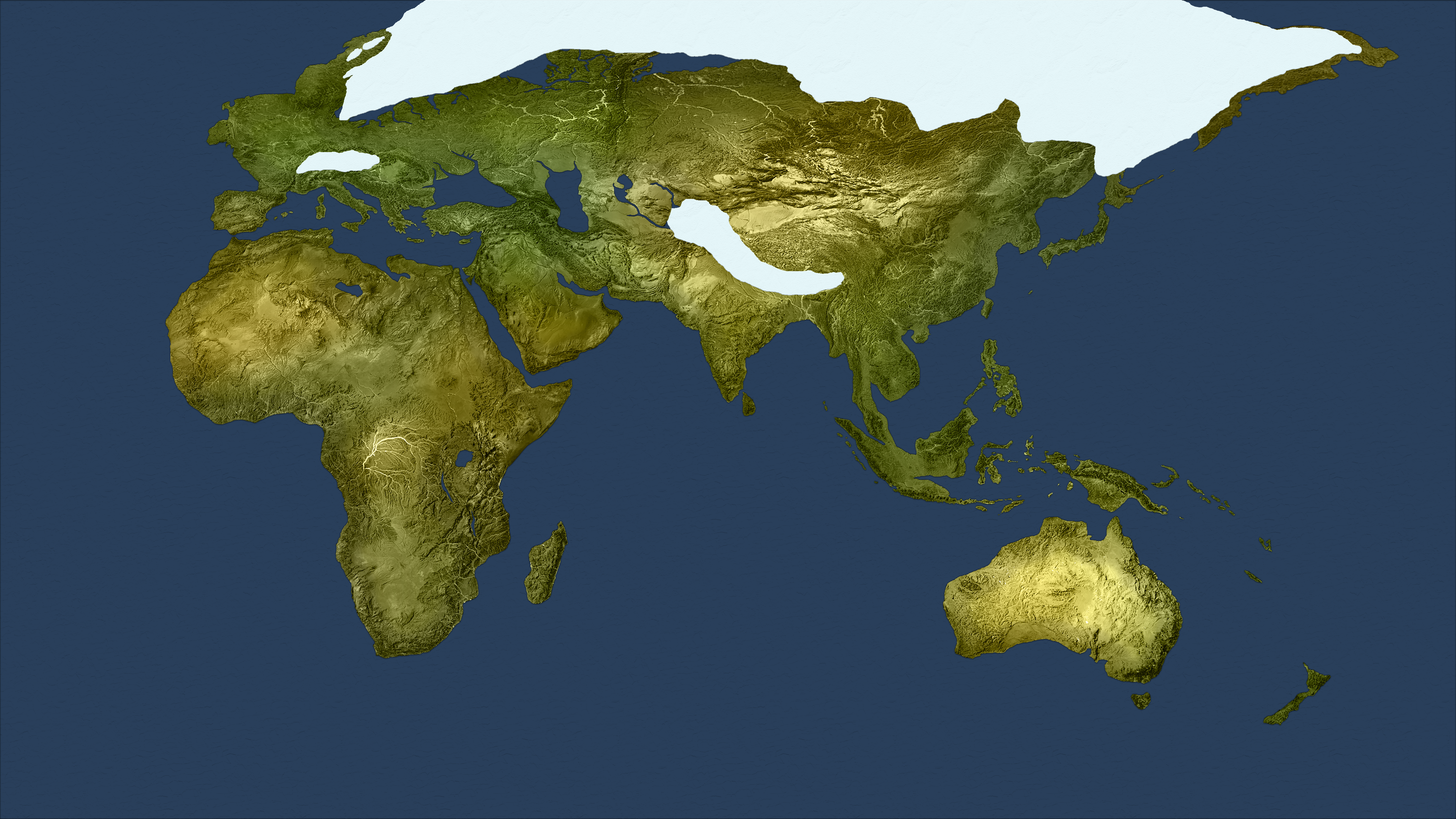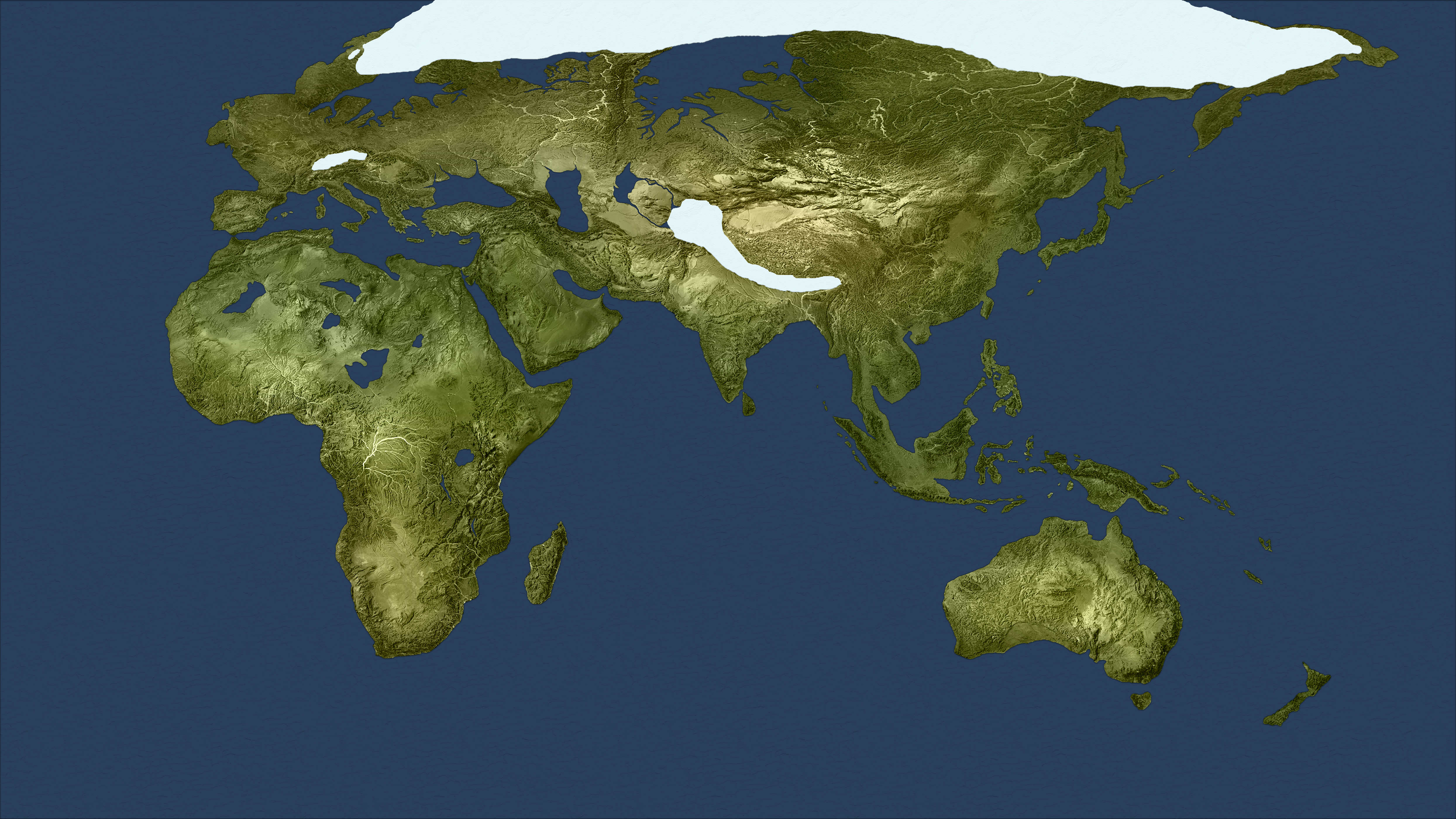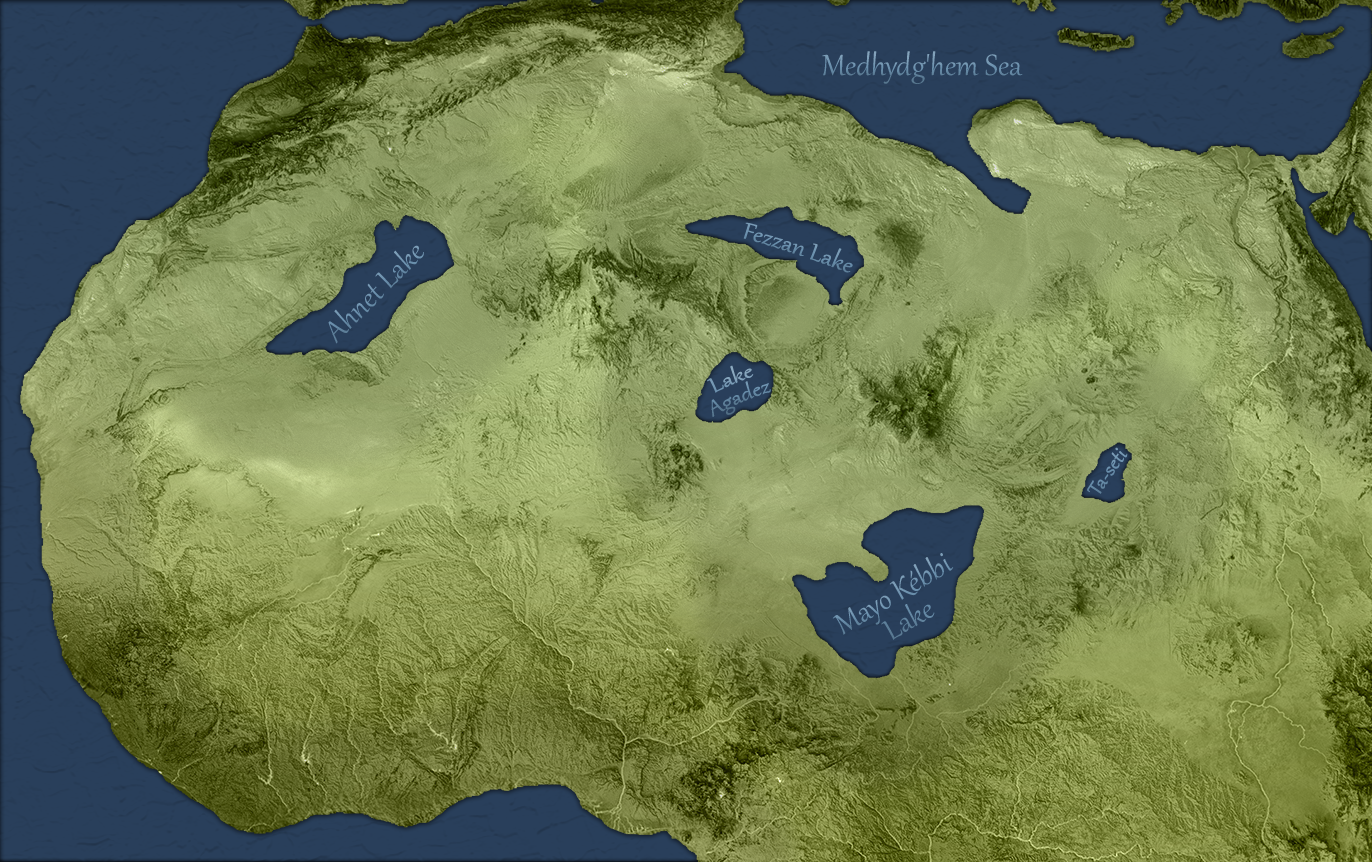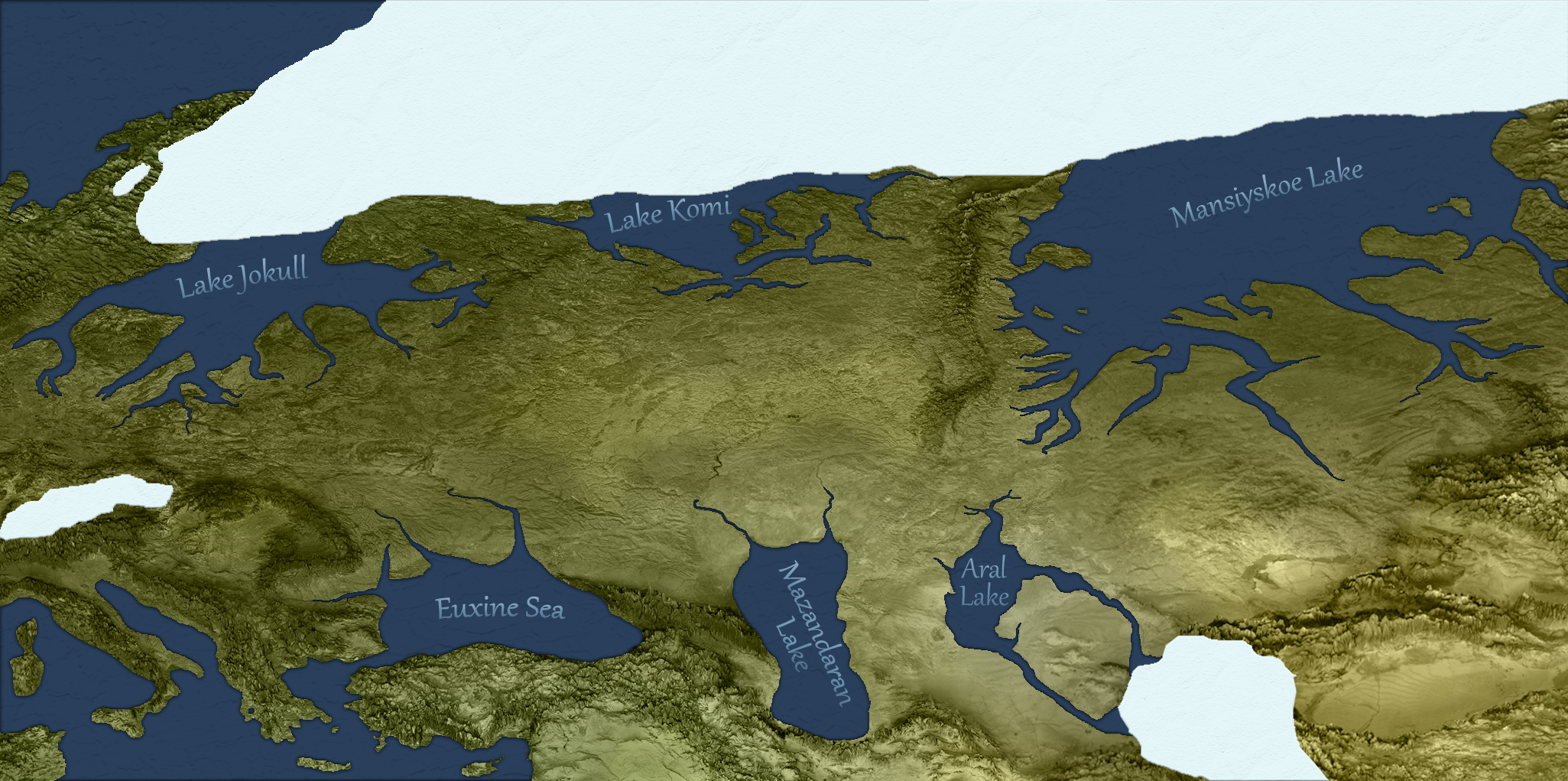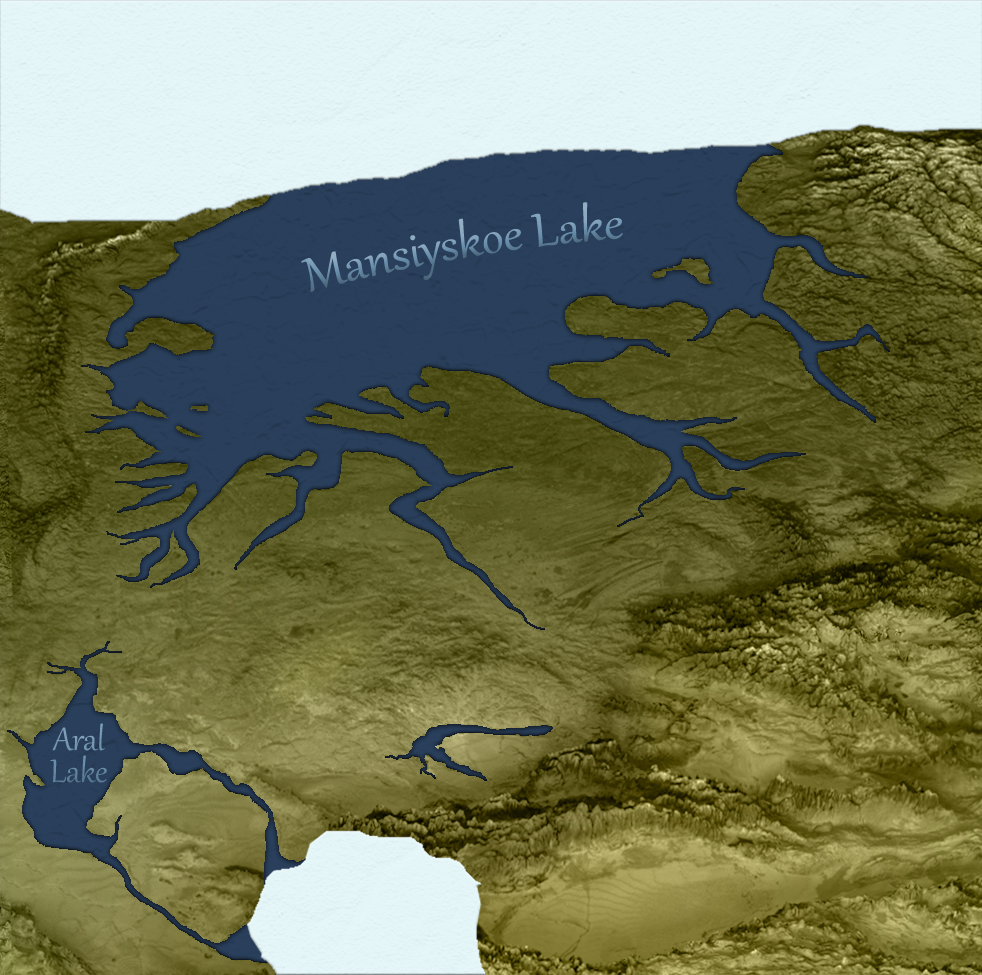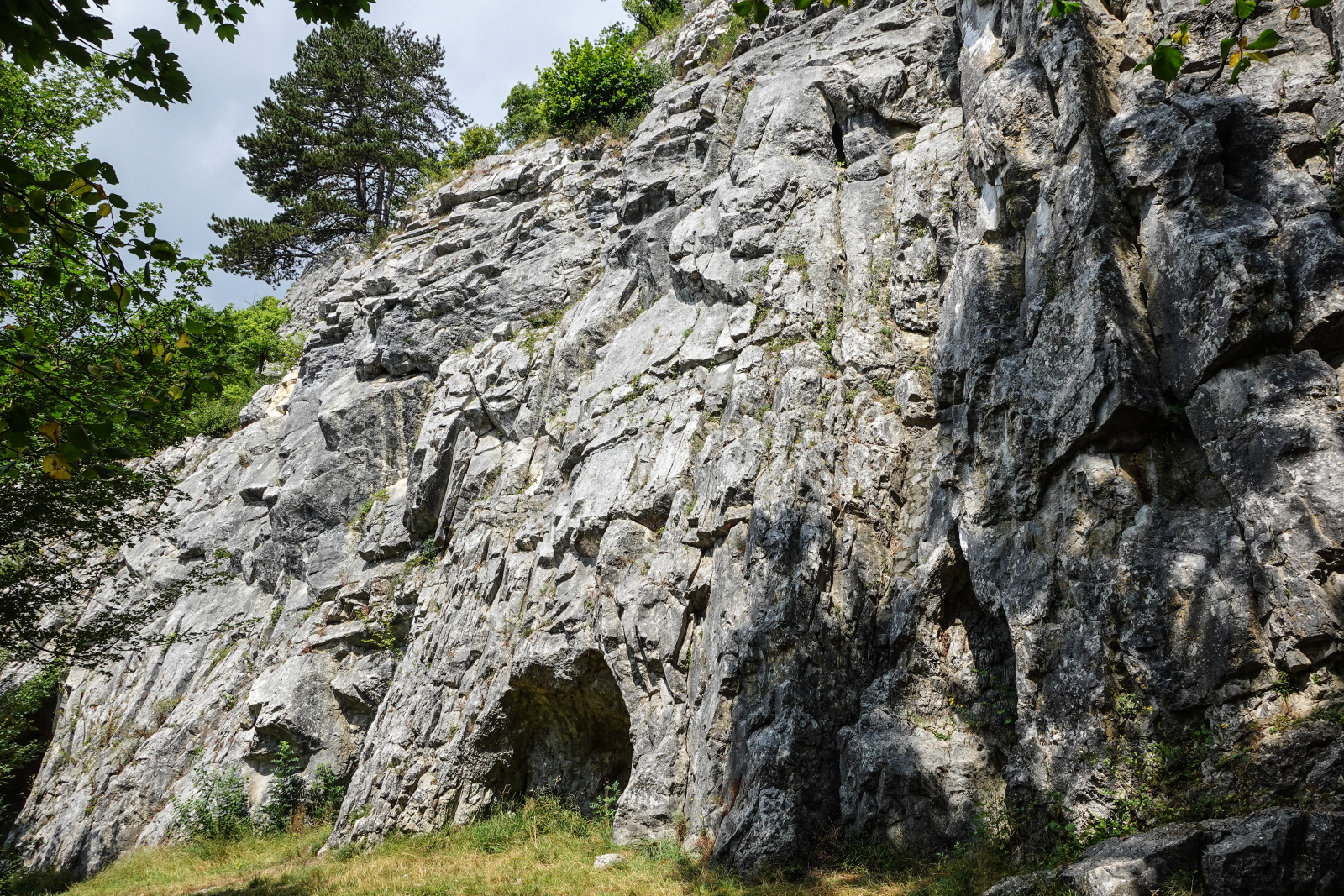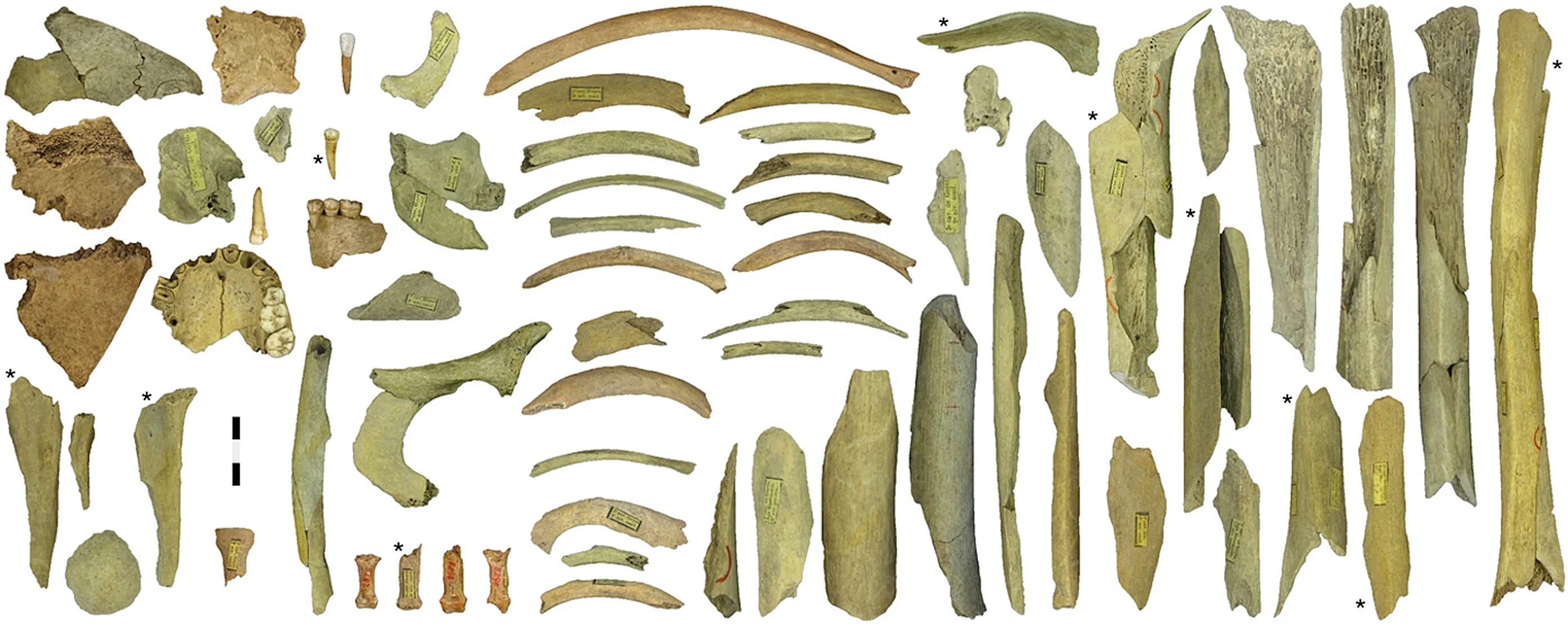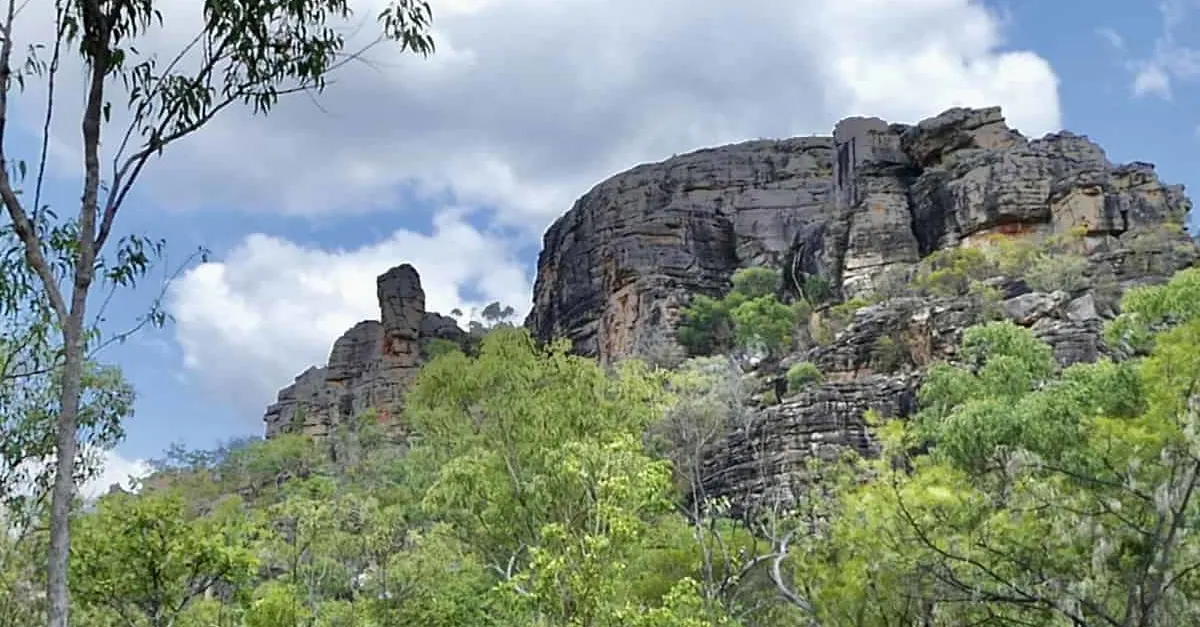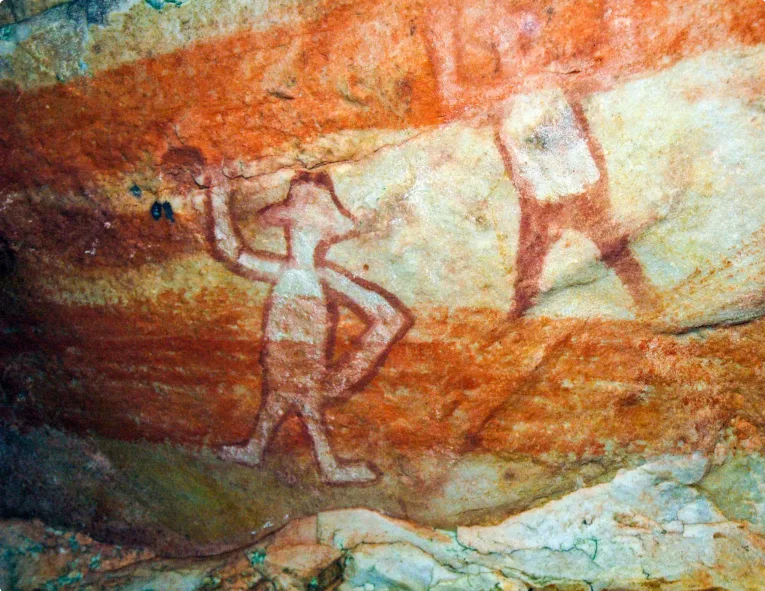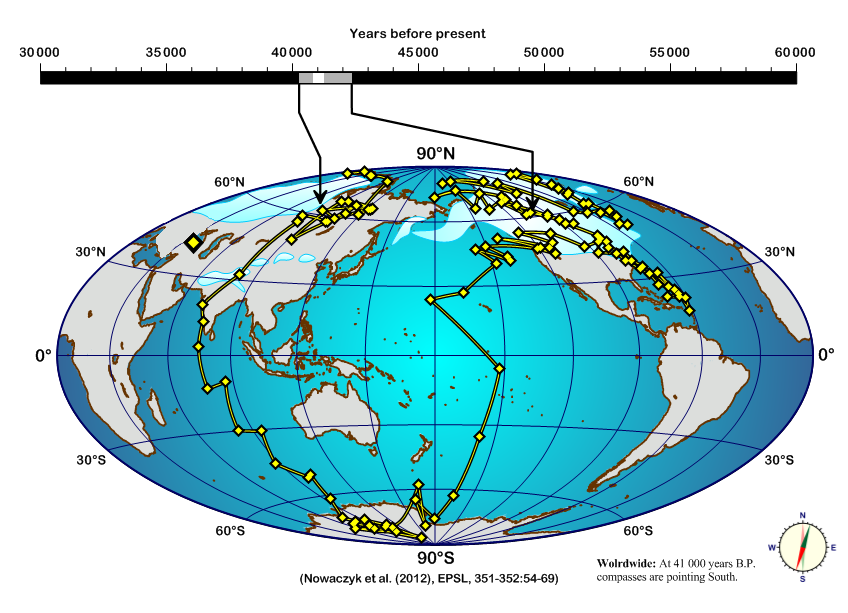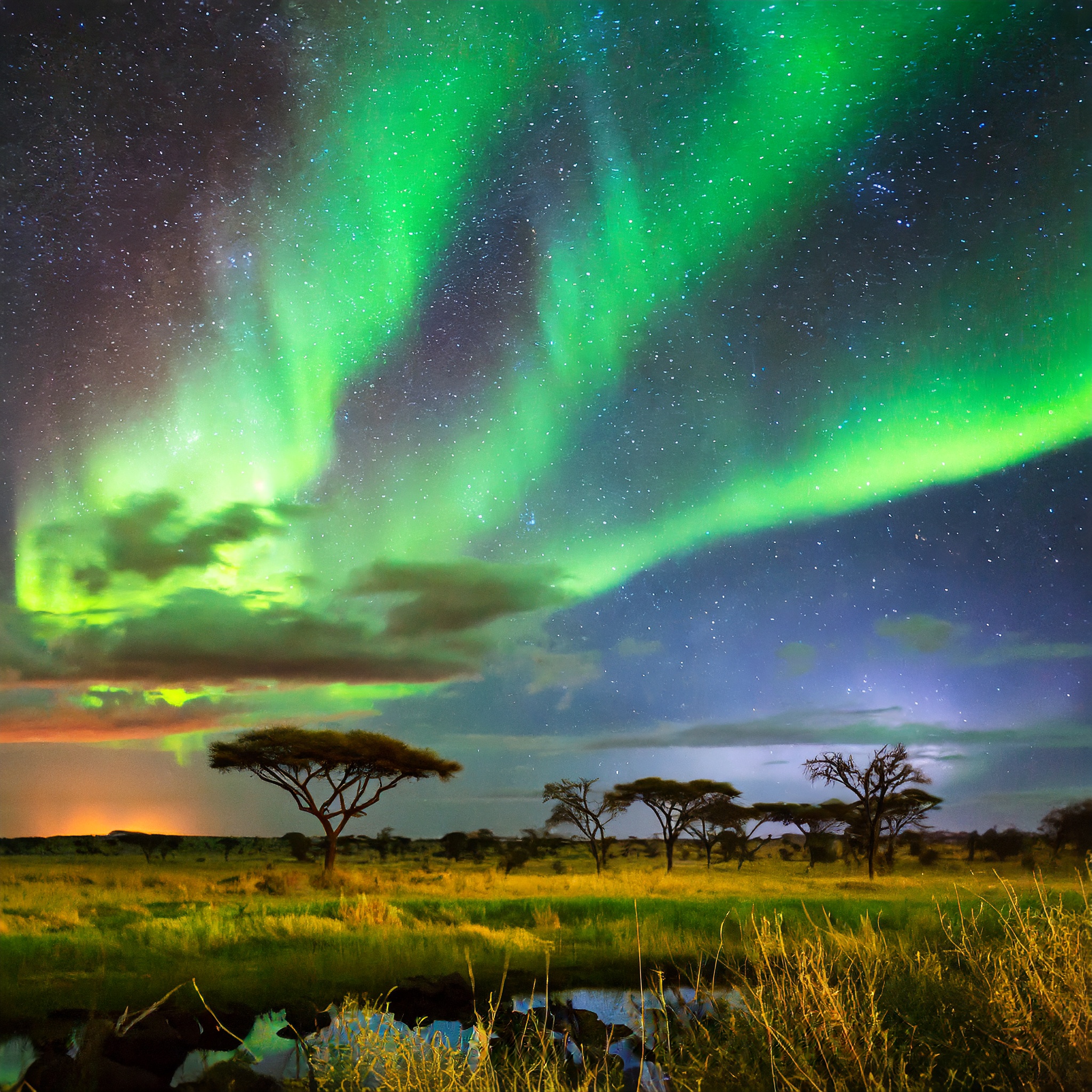Pluvial Turning (/ˈplu.viˌal ˈtɜːnɪŋ/)
(54,100 BP - 40,150 BP)
The Pluvial Turning1 was a stable, warm, and humid era that lasted approximately fourteen thousand years.2
Climate and Ecology
The end of the previous tādhēskō was marked by a sudden spike in global temperature that lasted more than three millennia, followed by a prolonged period of extremely warm and stable seasons. The global average temperature during this "golden age" turning was not as high as either the previous Pagsian or later Kara'apian eras. However, the initial temperature spike caused rapid melting of glaciers and led to a swell of inland lakes and in many regions led to humidity levels being higher than they are today. In Europe, barren steppes transformed into grasslands and then lush forests within the span of just a few lifetimes. Western Skáney was entirely ice-free during most of this period,3 and by the end of the turning western and southern Africa had regained their thick tropical forests.Wet Northern Africa (52,280 - 46,610 BP)
The spike in global temperature that marked the onset of this turning caused a corresponding spike in humidity across the tropical belt. Within only a few millennia, Sa'hra, Sahel, and Arabia transformed from arid steppe to grasslands and finally to thick lush forests.4 Northern Africa became speckled with lakes, just as it was during the Pagsian Turning.Eurasian Meltwater Lakes (48,500 - 43,020 BP)
The melting of glaciers covering Sibir and northern Europe accelerated, releasing massive volumes of water that had no pathway to reach the ocean. This water collected in inland basins, forming inland freshwater lakes across northern Europe and Asia that grew to massive sizes as the turning progressed. The largest of these was Mansiyskoe Lake, forming in Ariana and Sibir, which swelled to cover more than 881,000 square kilometers at its maximum extent. Other lakes that grew to enormous sizes during this period were Lake Komi, forming to the west of the Ural mountains, and Lake Jokull, forming over and around Skáney. Once global temperatures stabilized, glacial melting slowed and the lakes slowly began to drain through networks of tributaries that connected through Aral Lake, Mazandaran Lake, and Euxine Lake to eventually reach the sea. This process was slow, however, and massive inland lake still dominated Europe and Asia through the end of the turning.Laschamps Excursion (43,650 - 40,150 BP)
The uniquely disruptive and defining natural phenomenon of the Pluvial Turning was the event known by geologists and physicists today as Laschamps Excursion.5 Daylight became dangerous during this period, especially for neanders who had low levels of skin pigmentation. Being outside in direct sunlight during midday could cause life-threatening burns, even on cloudy days. Those who did not experience immediate burns often later developed fevers and would fall ill or even die, despite having no apparent wounds. Night time, on the other hand, was a spectacular and miraculous lightshow: auroras like the ones we associate with "northern lights" and "southern lights" lit up the night sky around the globe on a nightly basis. Rather than being limited to polar areas, auroras spread like fire across the skies over the rainforests of Damara and the fields of Arabia, and blanketed Europe from Iberia to Ural. These auroras were more intense in the northern skies, and so for the humans in northern Africa they appeared like cosmic signals calling them northward.Cultures
With ecosystems on every continent blooming from the sudden onset of warmth and moisture, life became very easy for humans and created new and unusual challenges for neanders. This poduced largest mass migrations that the world had yet seen.6Emergences
The Apo Duat humans established themselves in Wallacia. After a few millennia of both fighting and genetic mixing with the indigenous Bougain denisova, several human clans set out to explore Sahul. The humans quickly spread across the entire continent, giving rise to the Bininj, Wanjina Wunggurr, Martidja Banyjima, Noongar, Kukatha, Kokojelandji, Koori, Gunditjamara, Thura-Yura, Aṉangu, and Pintupi-Luritja cultural groups.7 Aterian humans migrating into Europe passed through the Levant, where they encountered the Emiran people as shining examples of a successful mixed human-neander culture. When they continued northward they spread out in all directions, giving rise to the Satsurblian, Ganj Par, Kashafrud, Chatyr Kol, Bohunician, Uluzzian, and Aurignacian cultures in Europe and Asia. Other cultures that emerged as the humans spread out to take advantage of the improving climate included the Zhoukoudian culture in Chang Jiang Pingyuan, and the Dabban, Ounjougou, and Khormusan cultures in northern Africa.Encounters
The influx of humans into Europe right at the start of Laschamps Excursion was devastating for neanders. They watched as more and more clans of these strange new people began to appear in their lands, just as they began to fall sick of unknown new illnesses and strange burns on their skin. And oh, the nighttime sky! It was as though the universe was boiling and coming to an end. Two groups were formed by humans and neanders coming together to form inclusive mixed cultured: the Châtelperians in Armorica and the Szeletia in Dnieper-Volga. Both of these were short-lived, and the Châtelperian culture did not even last through the end of the turning. By contrast, a group of young neanders in Pontic Steppe fled southward to get away from the humans and ended up in violent conflict with the Mezmaiskaya neanders in the Caucusus, ultimately replacing them with their own Bondi culture. A handful of young, idealistic Moustrian neanders in the Sarmatic Plain gathered their resources headed eastward to find the land of the rising sun. After crossing the Ural mountains they encountered the Ust'-Ishim humans. Although the two groups could not communicate verbally, the youth and enthusiasm of the neanders inspired the humans. Not only did the humans provide food and encouragement, but several humans decided to accompany the neanders when they continued on their quest. As a result, when the explorers reached Tian Shan they founded neighboring societies: a Karakol society of neanders, and an Ust Karakol mixed-species society of both neanders and humans. Although the neanders were content in their beautiful new home, some humans could not give up the "itch" to explore even farther eastward. The open land was lush and inviting in the last two millennia of the Pluvial Turning, so the cost of simply setting off to explore seemed very low. Several human clans continued on the eastward path, resulting in the founding of Tolbaga culture in Altai and Yushuwan culture in the river valleys of northern Chang Jiang Pingyuan. When the Apo Duat humans first arrived in Wallacia, their relationship with the Bougain denisova was complicated. There was some fighting, there was some genetic mixing, but in the end the continual low-level conflicts were too much for the denisova: the remaining clans picked up and moved en masse onto a separate island to give the humans room.Extinctions
The Hušnjakovo neanders died out because of illness carried by humans and damage from Laschamps radiation. The Mezmaiskaya neanders were killed off by viscious attacks from the Bondi neanders. The Teshik-Tash neanders and Kulbulak humans wore each other down with mutual hatred until they both went extinct. Mixed-species cultures were transformed when their neander members died out: Emiran culture transformed into Ahmran culture, and Châtelperian culture disappeared and the remaining humans were absorbed into the surrounding Aurignacian culture. By the end of the turning, the original Moustrian culture of central Europe had fragmented, dwindled, and completely disappeared.Culture Map
It is important to remember that the map below does not represent all movement by all individuals of every species of person during the turning. This map captures only some of the most significant changes in a selection of the larger cultural complexes.Turning Type
Golden Age
Preceded By
Start Year
54,100 BP
End Year
40,150 BP
Succeeded By
Graphs, Photos, and Illustrations
Footnotes
1. The label Pluvial was introduced by Kenneth R. H. Mackenzie in 75 BP, and like most of the pre-Srīgosian turnings the name is unattested in writing contemporary to the turning and was purely constructed by Mackenzie. The challenge Mackenie faced when constructing a name for this turning was to create a name that was thematically consistent with but distinct from the other two "golden age" turnings in the overall taxonomy. Both the previous one (The Pagsian Turning) and the most recent one (The Kara'apian Turning) had names that could be reconstructed from contemporanious inscriptions in the Acheyawan language Kuraną. Their names were grounded in the Kuraną roots for peace and growth, respectively. For this turning, he turned to the most disinctive characteristic of this turning, the humidity and rainfall. The name pluvial has roots in the word for "rain" in Witulu, plovere, which also is the etymological basis for the later Latīnum word pluvia. Later scholars have criticized this construction as flawed, however, since Kuraną is not a direct ancestor language of Witulu. Kuraną is a creole of Kapte and U̯reku̯, whereas Witulu descends directly from U̯reku̯ having been adapted as the Polada and Terramare people migrated through Alpidia and into Apenninus. Moreover, some have noted also that the word "pluvial" had just entered the English lexicon as a technical term for "arising as a consequence of rain" in geology at the time when Mackenzie was developing his taxonomy, and that the term was therefore somewhat trendy in academic circles. His choice may have therefore been consciously or unconsciously influenced by this. The result is that out of all of the names for turnings in the Mackenzie taxonomy, this name comes across anachronistically modern. 2. The Pluvial Turning corresponds roughly to the interval of time that climatologists identify with Antarctic Isotopic Maximum (AIM) periods 14 to 10 and Greenland Stadial (GS) periods 15 to 9. This entire turning also falls within Marine Isotope Stage 3. Although climatologists that view changes at a "fine grained" level itentify multiple oscillations during this period, models that look at longer "wave forms" have pointed out that the period that we identify as the Pluvial Turning corresponds to a period of higher overall temperature and lower ice cover that can be extracted even from "noisy" ice core data (see, e.g., Rial & Saha, 2011). 3. See Kleman et al. (2021). 4. Please note that this turning is not the period that most ecologists and paleoclimatologists refer to using terms such as African humid period and green Sahara. Those terms in academic circles usually refer to the period roughly 14,600 BP to 4,800 BP, which corresponds approximately to the tail end of the Second Tādhēskō and the entirety of the Kara'apian Turning. The characteristics are similar because both the Pluvial and Kara'apian Turning are "Golden Ages" according to the typology introduced by Edward Kelley (see Appendix A for more discussion of turning types). Research from the NIOZ Royal Netherlands Institute for Sea Research (2009) has confirmed that these "Pluvial Africa" characteristics also appeared during all three of the "Golden Age" turnings: the Kara'apian Turning (12,000 - 5,000 BP), this Pluvial Turning (52,280 - 46,610 BP), and the Pagsian Turning (125,000 - 115,000 BP). 5. The name and technical description of Laschamps Excursion are both modern, of course. Based on evidence from iron content in rock layers, we now know that the earth's magnetic field began to weaken in 43,650 BP, followed by the wandering or "excursion" of the magnetic poles from the year 42,350 BP until the end of the turning in 40,150 BP. The overall strength of the earth's magnetic field reached less than 10% of its normal strength at its weakest point during this period. UV-B radiation levels in Europe increased by 20% due to significant ozone depletion, and the electromagnetic radiation and charged particles reaching the atmosphere and surface was 10 to 50 times more intense than than normal (see Vogt et al., 2007; Winkler et al., 2008). Because of this, starting in the summer of 43,650 BP and growing in intensity over the centuries, people who remained outside under direct sunlight would experience severe radiation burns. Fair skin was more prone to become burned and to develop cancer, making this phenomenon disproportionately harmful for neanders, although of course humans also were somewhat affected. The weakening of the magnetic field is also what caused auroras to appear all over the planet, caused by charged particles entering the atmosphere and releasing energy in the form of visible light. These scientific explanations were unknown at the time, of course, but the effects were dramatic and confusing, and were the impetus for the mass migrations northward into Europe and southward into Oceania that the human carried out with almost religious zeal. 6. Archeologists describe these migrations as Initial Upper Paleolithic (IUP) Expansions, which fall into two distinct clusters: an eastward expansion into Asia comprised of multiple waves initiated between 61,000 BP and 43,000 BP, and a northward expansion into Europe comprised primarily of a single wave initiated around 43,000 BP. Both clusters have their roots either in Emiran culture or in Aterian culture with Emiran influences. The dominant waves of the expansion into Asia were initiated by Kulbulak culture (61,262 BP), Adivasi culture (56,440 BP), and Ganj Par culture (43,010 BP), each of which were only the first step in eastward migration pathways across the continent. The dominant wave of expansion into Europe was initiated by Bohunician culture (43,320 BP) in Anadolu, which became the first stepping-stone into Europe for the founding of the Aurignacian, Uluzzian, and Szeletian cultures. 7. When a culture that has been around unchanged for many millennia forms that basis for one or more indigenous cultures alive today, we make a point of being cautious in how to include them in this project. On the one hand, we don't want to exclude them from this narrative completely because to do so can come across as just another form of erasure, which is a type of oppression that indigenous people have endured for centuries. One the other hand, the stories of indigenous people is theirs to tell, and theirs alone. We do not want to contribute to speculation or "fictionalizing" of indigenous cultures by people who do not have an authentic connection to the culture. As a result, the pages for cultures having direct connections to existing indigenous peoples all bear a notice and expression of respect for indigenous people who have been suffered for centuries under colonization, and many of whom suffer still.Turnings Index
Type Key



